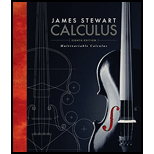
Concept explainers
(a) Write the general form of a second-order homogeneous linear differential equation with constant coefficients.
(b) Write the auxiliary equation.
(c) How do you use the roots of the auxiliary equation to solve the differential equation? Write the form of the solution for each of the three cases that can occur.
(a)
To write: The general form of a second-order homogeneous linear differential equation with constant coefficients.
Answer to Problem 1RCC
The general form of a second-order homogeneous linear differential equation with constant coefficients is
Explanation of Solution
Formula used:
Consider the second-order linear differential equation as follows.
Here,
If
Consider the value of
Substitute
Consider
Substitute
Thus, the general form of a second-order homogeneous linear differential equation with constant coefficients is
(b)
To write: The auxiliary equation.
Answer to Problem 1RCC
The auxiliary equation of the second-order differential equation is
Explanation of Solution
Modify equation (3) as follows.
In equation (4), function
Consider a exponential function for
Differentiate
Differentiate
Substitute
Since, the value of
Equation (6) is known as characteristic equation or auxiliary equation of the second-order differential equation
Thus, the auxiliary equation of the second-order differential equation is
(c)
To explain: The use of roots of the auxiliary equation to solve the differential equation and write the form of the solution for each of the three cases.
Answer to Problem 1RCC
The use of roots of the auxiliary equation to solve the differential equation is explained.
The form of the solution for each of the three cases is written.
Explanation of Solution
Formula used:
Consider the second-order differential equation as follows.
Write the expression for quadratic formula.
Modify equation (7) as follows.
Modify equation (8) as follows.
Thus, the use of roots of the auxiliary equation to solve the differential equation is explained.
Three different cases are obtained depending upon the term
Case I:
Consider the value of
In this case, the roots of auxiliary equation are real and distinct. So two linear independent solutions are occurs such as
Write the expression for general solution.
Here,
Substitute
Case II:
Consider the value of
In this case, the roots of auxiliary equation are real and equal.
Consider
Substitute
Case III:
Consider the value of
In this case, the roots of auxiliary equation are complex numbers.
Consider
Write the expression for general solution with complex roots.
Thus, the form of the solution for each of the three cases is written.
Want to see more full solutions like this?
Chapter 17 Solutions
Multivariable Calculus
- 2. Find a matrix A with the following qualities a. A is 3 x 3. b. The matrix A is not lower triangular and is not upper triangular. c. At least one value in each row is not a 1, 2,-1, -2, or 0 d. A is invertible.arrow_forwardFind the exact area inside r=2sin(2\theta ) and outside r=\sqrt(3)arrow_forwardA 20 foot ladder rests on level ground; its head (top) is against a vertical wall. The bottom of the ladder begins by being 12 feet from the wall but begins moving away at the rate of 0.1 feet per second. At what rate is the top of the ladder slipping down the wall? You may use a calculator.arrow_forward
- Explain the key points and reasons for the establishment of 12.3.2(integral Test)arrow_forwardUse 12.4.2 to determine whether the infinite series on the right side of equation 12.6.5, 12.6.6 and 12.6.7 converges for every real number x.arrow_forwarduse Cauchy Mean-Value Theorem to derive Corollary 12.6.2, and then derive 12.6.3arrow_forward
 Calculus: Early TranscendentalsCalculusISBN:9781285741550Author:James StewartPublisher:Cengage Learning
Calculus: Early TranscendentalsCalculusISBN:9781285741550Author:James StewartPublisher:Cengage Learning Thomas' Calculus (14th Edition)CalculusISBN:9780134438986Author:Joel R. Hass, Christopher E. Heil, Maurice D. WeirPublisher:PEARSON
Thomas' Calculus (14th Edition)CalculusISBN:9780134438986Author:Joel R. Hass, Christopher E. Heil, Maurice D. WeirPublisher:PEARSON Calculus: Early Transcendentals (3rd Edition)CalculusISBN:9780134763644Author:William L. Briggs, Lyle Cochran, Bernard Gillett, Eric SchulzPublisher:PEARSON
Calculus: Early Transcendentals (3rd Edition)CalculusISBN:9780134763644Author:William L. Briggs, Lyle Cochran, Bernard Gillett, Eric SchulzPublisher:PEARSON Calculus: Early TranscendentalsCalculusISBN:9781319050740Author:Jon Rogawski, Colin Adams, Robert FranzosaPublisher:W. H. Freeman
Calculus: Early TranscendentalsCalculusISBN:9781319050740Author:Jon Rogawski, Colin Adams, Robert FranzosaPublisher:W. H. Freeman
 Calculus: Early Transcendental FunctionsCalculusISBN:9781337552516Author:Ron Larson, Bruce H. EdwardsPublisher:Cengage Learning
Calculus: Early Transcendental FunctionsCalculusISBN:9781337552516Author:Ron Larson, Bruce H. EdwardsPublisher:Cengage Learning





